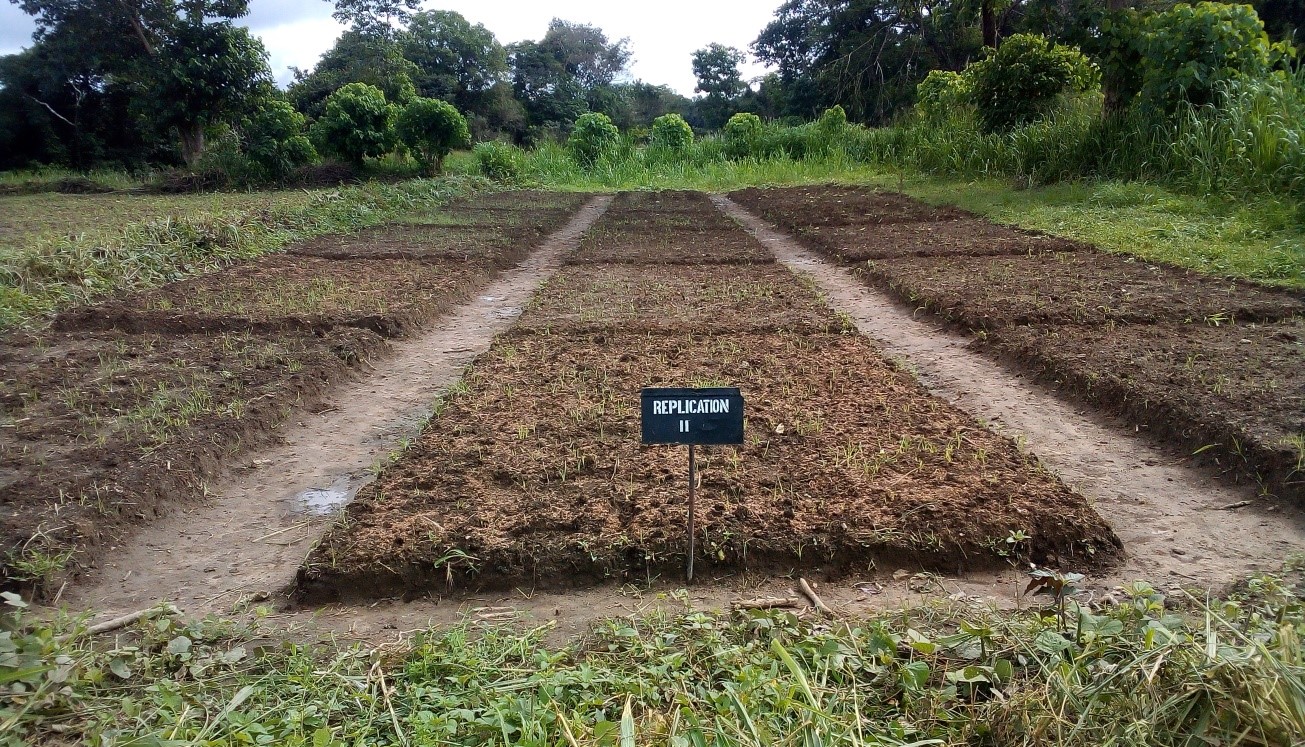Growth and yield response of Okra to method and time of poultry manure application under rain-fed conditions
Keywords:
Crop demand; Nutrient supply; Okra (Abelmoschus esculentus); Poultry manure; SynchronyAbstract
Matching nutrient demand with supply is critical for plant growth, development and yield. This study investigated the growth and yield response of Okra (Abelmoscus esculentus) to the method and time of poultry manure application, in order to match the time of optimum nutrient release with nutrient uptake by the okra plants. A randomized complete block design with 6 treatments and 3 replicates was used for this study. The poultry manure was applied at three different times: During planting (0-DOP), 2 weeks after planting (2-WAP) and 4 weeks after planting (4-WAP) using two application methods: surface-broadcasting and plow-incorporation. Results showed significant differences in method and time of application of poultry manure. The application of poultry manure, using plow-incorporation method on the day of planting (0-DOPI), significantly improved growth and yield (5.88 t ha-1) of okra. Also, 0-DOPI treatment took fewer days to attain 50% flowering (55 days) and fruit setting (58 days). This indicated that the match between nutrient demand and supply was most evident under 0-DOPI treatment. However, the surface broadcasting method at 2-WAP and 4-WAP, could not match release and supply of nutrients with critical developmental stages of okra. Hence, poultry manure incorporation at time of planting could improve okra production in the study area.
References
Adekiya, A. O. and Agbede, T. M. (2016). Effect of methods and time of poultry manure application on soil and leaf nutrient concentrations, growth and fruit yield of tomato (Lycopersicon esculentum Mill). Journal of the Saudi Society of Agricultural Sciences, 1 - 6. http://dx.doi.org/10.1016/j.jssas.2016.01.006
Cassman, K. G., Dobermann, A. and Walters, D. T. (2002). Agro-ecosystems, nitrogen-use efficiency, and nitrogen management. Ambio, 31: 132-140.
Dauda, S. N., Ajayi, F. A. and Ndor, E. (2008). Growth and yield of water melon (Citrullus lanatus) as affected by poultry manure application. Journal Agricultural and Social Sciences, 4: 121-124.
Fawole, O. B., Ajayi, T. J. Aduloju, M. O. and Olaniyan, J. O. (2010). The use of Parkia husk and melon wastes as soil amendment. Journal of Agricultural Research and Development, 9 (2): https://africaneditors.org/journal/JARD/abstract/02903-35778
Gana, A. K. (2011). Appropriate method for organic manure application for higher sugarcane yield in Nigeria. Journal of Agricultural Technology, 7(6): 1549-1559.
Gemede, H., Haki, G. D., Beyene, F., Woldegiorgis, A. Z. and Rakshit, S. K. (2015). Proximate, mineral, and antinutrient compositions of indigenous Okra (Abelmoschus esculentus) pod accessions: Implications for mineral bioavailability. Food Science and Nutrition, 4 (2): 223 – 33.
Havlin, J. L., Beaton, J. D. Tisdale, S. L. and Nelson, W. L. (2005). Soil Fertility and Nutrient Management. Pearson Education Ltd., United Kingdom.
Jokela, W. E. and Meisinger, J. J. (2008). Ammonia emissions from field-applied manure: management for environmental and economic benefits. Proceeding of the 2008 Wisconsin Fertilizer, Aglime and Pest Management Conference, Madison, Wisconsin, January 15-17 2008, 47: 199–208. http://www.soils.wisc.edu/extension/wfapmc/
Mayhew, S. and Penny, A. (1988). Tropical and Subtropical Foods. MacMillan Publisher Ltd., London.
Ojoniyi, S. O. (2013). Effect of organic manure on soil nutrient and okra yield in the rainforest area of Nigeria. Applied Tropical Agriculture, 1: 20 - 23
Ozores-Hampton, M. (2012). Developing a vegetable fertility program using organic amendments and inorganic fertilizers. Horticultural Technology, 22 (6): 742-750.
Pallardy, S. G, (2008). Physiology of woody plants. 3rd edn. New York, Elsevier Inc.: 39–377
Peyvast, G. H., Ramezani-Kharazi, P. Tahernia, S. Nosratierad, Z. and Olfati, J. A. (2003). Municipal solid waste compost increased yield and decreased nitrate amount of broccoli Brassica oleracea var. Italica. Journal of Applied Horticulture, 10 (2): 129-131.
Purseglove, W. J. (2008). Tropical Crops (dicotyledons). Longman, London,
Smil, V. (2001). Enriching the Earth: Fritz Haber, Carl Bosch, and the Transformation of World Food Production. USA, Massachusetts Institute of Technology Press.
Steward, M. (2006). Conserving resources and building productivity: a case for fertilizer BMPs. Better Crops, 90 (2): 4-6.
Vuure, W. van, Odell, R. T. and Sutton, P. M. (1972). Agronomy Handbook. Sierra Leone, University of Sierra Leone Academic Press.
Yafan, H. and Barker, A. V. (2004). Effect of composts and their combinations with other materials on nutrient accumulation in tomato leaves. Communications in Soil Science and Plant Analysis, 35(19-20): 2809-2823.

Downloads
Published
Versions
- 10/18/2022 (3)
- 10/11/2022 (2)
- 10/11/2022 (1)




